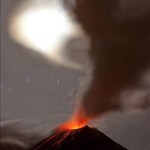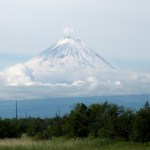Ecuador
Just a reminder, if you any questions for Sally Kuhn Sennert of the Smithsonian/USGS Global Volcanism Program - about the Weekly Report, about life at the GVP, about volcanoes - be sure to send them to me soon at .
Now, on to this week's update!
Some highlights (not including Gorely):
Lahars from Tungurahua in Ecuador moved blocks upwards of 2 m in diameter downstream over the last week and ash fall was reported over 20 km from the volcano's vent. For some reason, FoxNews decided to use an image of Tungurahua for an article on stats of natural disasters in 2009 - nice image, but the volcano…
Tungurahua in Ecuador erupting on May 31, 2010.
Two volcanoes along the edge of the north Pacific had explosive eruptions over the weekend. We have some more details on both of the eruptions, so I'll pass them on:
Bezymianny
KVERT is excited because they claim to have predicted the explosive eruption of Bezymianny almost to the day. They had been closely monitoring the volcano and issued this statement on May 20:
According to satellite data by AVO and KVERT staff, a temperature of
the thermal anomaly over the lava dome of Bezymianny volcano began
increasing from May 19 (from -1 (9:49 UTC) to…
Dark ash covers an American Airline 737 on the tarmac at the airport in Guatemala City.
Two volcanoes are making headlines right now (and neither is in Iceland).
As I mentioned yesterday, Pacaya in Guatemala erupted (video) causing widespread disruption of life in the nearby Guatemala City and costing two people their lives (including a TV reporter who got too close to the vent). Almost 2,000 people have been evacuated from the region near the volcano. The BBC has posted some impressive video of the eruption of Pacaya, showing the strombolian explosions sending basaltic tephra high into the…
Ah yes, a reminder that there are other volcanoes erupting around the world than Eyjafjallajökull - but yes, it is true! Here is the latest USGS/Smithsonian Global Volcanism Program Weekly Volcanic Activity Report!
Highlights (not including Iceland) include:
Another volcano in the Kuril Islands of Russia is showing signs of, well, something. Ketoi was noticed to be experiencing increased fumarolic activity according to satellite images. Ketoi hosts a Pleistocene caldera but has had three historic eruptions over the last few centuries, most recently in 1960, and all of which were explosive…
The flu has retreated and I'm getting back on track. Huzzah!
I'll get back to the blog by posting this week's new USGS / Smithsonian Institution Global Volcanism Program Weekly Volcano Report. Looks like some interesting stuff in it ...
Looks like there were some small eruptions from Oldoinyo Lengai in Tanzania. The volcano is one of the few (only active?) carbonatite volcanoes in the world, erupting a lava composed primarily of calcium carbonate and sodium minerals with very little silica. It leads to the odd lava that erupt black (and cool ~ 500C) and cool to white, making it one of the…
Tungurahua erupting in an undated AP photo (although I think it is the current 2010 activity.)
It hasn't really made it to much of the English-speaking news, but the current eruptive activity at Tungurahua appears to be on the up-tick. Hugo Yepes of the Geophysical Institute of Ecuador suggests that a larger eruption is not out of the question (link in spanish), but right now the activity is confined to explosions (vulcanian?) and ash fall around the region, specifically on Pillates and Choglontus overnight (2/1) from the ~ 2 km / 5 000 foot plume. Looking at the specifics (link in spanish…
Some news for the last Friday in January:
Volcanic lightning captured over Redoubt in March 2009.
Tungurahua in Ecuador continues to erupt. Yesterday, the volcano spread ash over much of central Ecuador. Apparently people in Ecuador aren't taking the hazard of ash too seriously, with many ignoring recommendations to wear masks when the ash is falling. Over 50 explosions have been recorded over the last 24 hours at the volcano according to the Ecuadorian Instituto GeofÃsico, most of them small to moderate.
We also have a new USGS/Smithsonian Institute Volcano Activity Report. Much of the "…
Somehow I haven't posted a bunch of interesting items collected over the last few weeks, so I need to catch up. A pre-emptive hat tip to everyone who has sent me links or notes that might seem familiar in this post.
Tungurahua in Ecuador erupting in 2000.
First off, those of you looking for information on the Haitian earthquake that devastated the capitol Port Au Prince, Highly Allochthonous has post on the tectonics of the quake. Right now, it is hard for me to come up with a worse location in terms of devastation for a quake to have hit in the Caribbean Basin.
Back in volcano news, a lot…
tags: evolutionary biology, immunology, immune response, antibodies, parasite, avian pox virus, Poxvirus avium, nest fly, Philornis downsi, birds, ornithology, Darwin's Finches, Medium Ground Finch, Geospiza fortis, Ecuador, Galapagos Islands, researchblogging.org,peer-reviewed research, peer-reviewed paper
A male Medium Ground Finch, Geospiza fortis, sits on a tree branch in Ecuador's Galapagos Islands.
Image: Jen Koop.
People often view the Hawaiian islands as a tropical paradise, the ideal vacation site, but you wouldn't agree with this assessment if you happen to be a bird. According…
We get a new update from the Smithsonian/USGS Global Volcanism Program ...
Highlights (not counting Soufriere Hills or Gaua) include:
The Weekly Report mentions the mystery eruption/noneruption of Karkar in PNG. Specifically, they report:
The report also stated that ash had merged with a thunderstorm cloud and had become unidentifiable.
Two ash plumes (11/25, 26) that reached at least 9.1 km / 30,000 feet were reported by the Darwin VAAC ... but as we know, it is far from clear that anything actually happened at Karkar last week.
Activity has quieted significantly at Chaiten in Chile, with…
The SI/USGS GVP site is back up and running - and they've posted a new weekly volcano activity report. Enjoy!
Highlights include:
Nevado del Huila in Colombia has been showing signs that a new eruption might be starting. Seismicity has increased and minor ash fall has been reported, leading to an increase in the alert level at the volcano to "orange" (high).
Ebeko in the Kuril Islands off Russia and Japan produced a ~8.8 km / 29,000 foot ash plume.
Thermal images of the crater at El Reventador in Ecuador show that hot material is filling in the dome complex - this followed ash-and-steam…
I did an excellent job of forgetting my notes from GSA 2009, so no wrap up on the meeting until tomorrow, but we do have some new volcano news to digest:
The crater of El Reventador in Ecuador in an undated photo.
Ecuadorian officials have called for evacuations around El Reventador. The Ecuadorian Geophysics Institute says that the volcano's "activities were measured at a level considered high, with permanent seismic signals indicating explosions while the southern side of the volcano crater could be seen as incandescent.". Three provinces near the volcano were put on alert evacuated as a…
Somehow I missed a week of the SI/USGS Weekly Volcano Activity Reports and almost missed another. Here is this week's update!
Highlights (not including Chaiten, Soufriere Hills or Cleveland) include:
The alert level at Galeras in Colombia was raised to Red after an explosion on September 30 and returned to orange ... and then yellow ... after activity tapered.
Sakurajima in Japan produced 1.8-4.3 km / 6,000-14,000-tall ash-and-steam plumes, along with incandescent tephra that was thrown almost two kilometers from the vent.
Multiple steam-and-ash plumes reached 4.3 km / 14,000 feet at Langila…
I missed the weekly report last week (sorry), but here is the new USGS/SI volcano activity report.
Highlights include:
Shiveluch in Kamchatka is still erupting away, producing ~7 km / 20,000 foot ash columns as the lava dome grows. There has also been pyroclastic flows spotted emanating from the new lava dome.
There was a report of a ~7.5 km / 25,000 foot ash-and-steam plume from El Reventador in Ecuador.
More small plumes and incandescent lava bombs were spotted at the Tavurvur Crater at Rabaul in Papau New Guinea
The slow summer for volcanic eruptions continue. Only 11 updates in this week's USGS/SI report. Thanks again to SI's Sally Kuhn Sennert for compiling the news!
Highlights this week include (not including Kilauea) include:
Tungurahua in Ecuador produced some minor lahars on August 21 to go with steam-and-gas emissions.
Popocatépetl in Mexico produced an ash plume that reached ~8.2 km / 27,000 feet on August 20 and continued to produce steam-and-ash plumes throughout the week following.
Over on the Kamchatka Peninsula, both Koryaksky and Shiveluch produced significant ash plumes (reaching 3-5…
Busy today with scouting out some field location for the class I'll be teaching this fall. Here's this week's USGS/SI Weekly Volcano Report. The report is a little more eventful than last week's, so enjoy!
Kliuchevskoi Volcano in Kamchatka, taken summer of 2009 by Theresa Kayzar.
Highlights include:
Three volcanoes on the Kamchatka Peninsula are currently producing ash plumes: Kliuchevskoi, Koryaksky and Shiveluch. Shiveluch has been having the most intense eruptions, but the former two are both producing ash-and-steam plumes that reach over 3 km / 10,000 feet.
Talang in Indonesia saws its…
This is likely my last update until the end of next week sometime, so feel free to use it for any new volcano news you might see. Look for the Erebus Volcano Profile to be posted on Friday sometime, followed by the vote for the next Profile. Next time I post I'll be (back) in the eastern time zone!
With that, I leave you with the latest USGS/SI Weekly Volcano Report.
Highlights (not counting Shiveluch) include:
Small ash plumes were spotted several times from Batu Tara in Indonesia.
Explosions, ashfall and earthquakes were reported at Nevado del Huila in Colombia.
There were reports of…
A wrap up of the week's volcanism, brought to you by Sally Kuhn Sennert and the USGS/SI Global Volcanism Program.
Highlights, not including Sarychev Peak, Redoubt and Shiveluch (busy week in the north Pacific), include:
A small ash cloud was spotted at Bagana in Papua New Guinea.
The Tavurvur cone at Rabaul (PNG) continues to glow at night and produce small ash/steam plumes.
The Santiaguito dome at Santa Maria in Guatemala produced 8,000-10,000 foot / ~2.9-3.3 km ash plumes, along with a lahar that carried blocks over 1.5 m downstream from the volcano.
A 25,000 foot / 7.6 km ash plume was…
The Q&A post will be coming over the weekend (there's still time to send me a question!)
Icy cold volcanoes (well, geysers) on Enceladus, a moon of Saturn.
In the meantime, here are a few quick hits:
Mt. Cleveland in the Aleutians had a small eruption. The plume was only ~15,000 feet / ~3 km. Cleveland is one of the more active volcanoes in the Aleutians, so this eruption is not out of the norm.
Landslides and rockfalls at Arenal (in spanish) in Costa Rica continue to prompt evacuations of tourists near the volcano. It is interesting to note that officials don't seem worried about hotel…
Busy busy analysing on the multicollector ICP-MS today (but not busy enough to miss this).
Here's your weekly volcano news roundup from the USGS/Smithsonian GVP.
Highlights (not including Sarychev Peak) include:
Continued dome growth and degassing at Bezymianny in Russia. Starting next year, there will be live webcams for three of the major volcanoes (Bezymianny, Kliuchevskoi, and Shiveluch) on the Kamchatka peninsula! Now, that is exciting news.
The glowing coming from the vent in the Halema'uma'u Crater at Kilauea in Hawai'i is still prominent. The lava levels in the crater have been…

